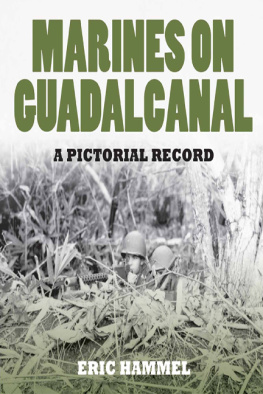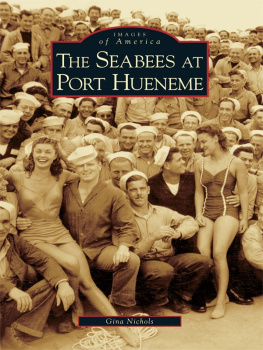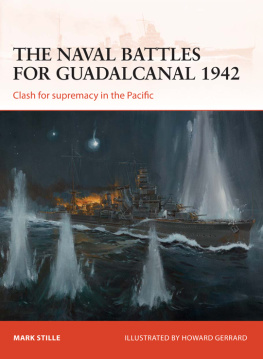CAN DO!

Foreword 1997 by the U.S. Naval Institute, Annapolis, Maryland
Originally published in 1944 by E. P. Dutton & Company, Inc.
First Bluejacket Books printing, 1997
ISBN 978-1-61251-679-0 (eBook)
Library of Congress Cataloging-in-Publication Data
Huie, William Bradford, 19101986.
Can do! : the story of the seabees / William Bradford Huie.
p. cm.
Originally published: New York : E. P. Dutton, 1944.
Includes index.
1. Huie, William Bradford, 19101986. 2. United States. Navy. Construction BattalionsHistory. 3. World War, 19391945Naval operations, American. 4. World War, 19391945Personal narratives, American. 5. SailorsUnited StatesBiography. 6. United States. NavyBiography. I. Title
D769.55.H8 1997
16 15 14 13 12
To the free American craftsmen who, in December, 1941, chose to work where bombs were falling; to my countrymen with educated hands who, when the enemy struck, volunteered to endure mud and loneliness, disease and blasting death, that they and their nation might remain free, this book is dedicated.
... The accomplishments of the Seabees have been one of the outstanding features of the war. In the Pacific, where the distances are great and the expeditious construction of bases is frequently of vital importance, the construction accomplished by the Seabees has been of invaluable assistance. Furthermore, the Seabees have participated in practically every amphibious operation undertaken thus far, landing with the first waves of assault troops to bring equipment ashore and set up temporary bases of operation. In the Solomon Islands campaign the Seabees demonstrated their ability to outbuild the Japs and to repair airfields and build new bases, regardless of conditions of weather. There can be no doubt that the Seabees constitute an invaluable component of our Navy.
From the official report by ADMIRAL ERNEST J. KING, Commander in Chief, United States Fleet, and Chief of Naval Operations
CONTENTS
, by Donald R. Noble
, by Ben Moreell
On 24 April 1943 William Bradford Huie was inducted into the U.S. Navy as apprentice seaman, USN-I. Later that day, Huie, who had never held a hammer professionally, and rarely as an amateur, was allowed to enlist voluntarily in the U.S. Naval Reserve and given the rank of chief carpenters mate (CCM-AA, V-6). He was to serve for a period of two years.
It was clear right from the start that Huies job was not to drive nails, but to write, explaining the newly formed Seabees to the nation and making sure that the Seabees got all the publicity and attention for their work that they deserved.
Huie reported for active duty on 29 April and was sent immediately to the Naval Construction Training Center, Camp Peary, Williamsburg, Virginia, until 24 June 1943. He was transferred to First Naval Construction Brigade, Port Hueneme, California, until 18 October 1943 and then to the Construction Battalion Replacement Depot, Camp Parks, California. He remained there until 17 November 1943, when he was transferred back East to Naval Barracks, Washington, D.C.
In moving from installation to installation, Huie was learning how the Seabees were trained, how they worked, what they were like. And he was interviewing those Seabees who had returned from the early battles in the Pacific. He was doing this research under the direct command of Vice Adm. Ben Moreell, chief of civil engineers and chief of the Bureau of Yards and Docks, and the youngest vice admiral in the U.S. Navy. The purpose of his research: he was to write Can Do! The Story of the Seabees.
Admiral Moreell had chosen wisely; Huie was perfect for the job. A professional, Huie had been writing every day of his adult life.
Born in Hartselle, Alabama, on 13 November 1910, Huie gave the valedictory address at Morgan County High School in May 1927. He claimed that while he was speaking, Lindbergh was landing in Paris.
Huie attended the University of Alabama in Tuscaloosa, planning to become a doctor or a lawyer, but while still an undergraduate in 1928 he sold a piece of short fiction to True Story magazine. From that time forward, he was a writer.
After graduating from the University of Alabama with a B.A., a major in English, and a Phi Beta Kappa key, Huie went to work for the Birmingham Post, covering, among many other things, the labor wars between the miners on one side and the mine owners with their hired Pinkerton armies on the other. Huie married his childhood sweetheart, Ruth Puckett, on 27 October 1935 and worked for the Post until 1936, when he cofounded the Cullman Banner in Cullman, Alabama. Huie would work in newspaper and magazine journalism in Alabama until 1938, when he spent several months in Los Angeles writing freelance magazine pieces and attempting to break into the screenwriting business.
In 1942, having returned to Alabama from California, Huie moved to New York City and became associate editor of American Mercury, H. L. Menckens old magazine, of which he would later become owner and publisher. He also wrote his first novel, the autobiographical Mud on the Stars (1942), in which his fictional counterpart, Peter Garth Lafavor of North Alabama, grows up, attends the University in Tuscaloosa, works as a newspaperman, and observes with initial misgivings the coming of the New Deal and the massive construction projects of the Tennessee Valley Authority. Lafavor finally becomes a Roosevelt supporter, an employee of the TVA and, at the end of the novel, an enlisted man in the U.S. Army, ready to fight for democracy.
On 11 January 1944 William Bradford Huie began his service as an officer and a gentleman. After a physical examination on 2 January, Huie was appointed lieutenant (jg), USNR, with an obligation for two years from that date. Within a few months, Can Do! (which he had been working on since April 1943) would be published by E. P. Dutton. It would go through four printings in that first year and four more in 1945. Like Huies best-selling novel, Can Do! was an enormously popular and successful book.
In this reprint edition, Can Do! will have two sets of readers: those who remember the years 194145 and those who do not. At the time the book first appeared, Huie had only the first setreaders who had been shocked by the attack at Pearl Harbor, dismayed by the American retreat across the Pacific, and heartened by American successes in the Aleutian Islands and in the early battles of the comeback, especially on Guadalcanal. The book had a number of purposes, then, one of which was to boost morale and confidence on the home front. Todays readers must not be too surprised to see Japanese soldiers described as bandy-legged rats. Nor should they expect unbiased reporting: When a Marine sees a Jap he shoots the bastards eyes out; when a Seabee spies a Jap he just spits a long, contemptuous stream of Copenhagen, and blinds the sonuvabitch! The book also explains the need for patience: building fuel depots, docks, and airfields takes time.
Another purpose of Huies book was to introduce the newly formed Seabees to his readers. On 7 December 1941 there were no Seabees. From the time of the American Revolution, construction and maintenance of shore facilities, all work done at docks and yards, was done by civilians. Abroad, the U.S. Navy used friendly ports and coaling stations, primarily British. Up until 1938, in fact, the United States had scanty and sparse bases in the Atlantic or Pacific. After 1938, when Japanese intentions in the Pacific became obvious, construction of American bases began at Midway, at Wake, at Guam, and at a number of other spots in the Pacific, but that work was being done by civilians. When Wake Island and, later, Guam were overrun by the Japanese in December 1941, the one thousand or so men working there were seized by the Japanese as prisoners of war, even though they were not in the military service. Instead of being interned as civilians, these men were put into a POW camp in Shanghai. Also, as civilians working for private contractors, the men were no longer on anyones payroll; how would they support their families back home?
Next page









